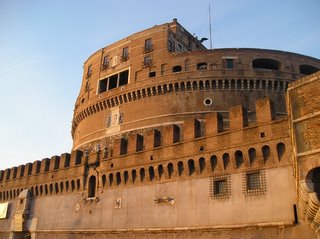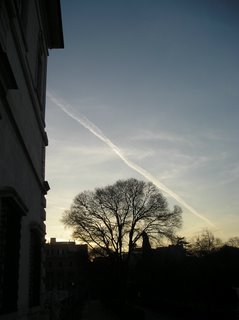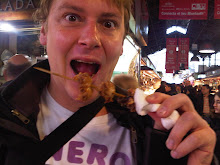Part II: Firenze e Roma
The constraints of museum opening hours dictated a hasty arrival and establishment of ourselves in Florence, followed by determined dash to the Uffizi.
 All this effort was worth it, giving us three hours in one of the best art museums in the world. Highlights included Monaco, Botticelli, . Plus the view out the window over the Arno was pretty good:
All this effort was worth it, giving us three hours in one of the best art museums in the world. Highlights included Monaco, Botticelli, . Plus the view out the window over the Arno was pretty good:

and the outdoor cafe, though chilly, was pretty picturesque:
 A couple of the rooms were closed & I felt a bit shortchanged that we'd missed out on seeing the Caravaggios. It turned out these were in the new rooms down stairs, along with some very dramatic Reni and Honthorst works,
A couple of the rooms were closed & I felt a bit shortchanged that we'd missed out on seeing the Caravaggios. It turned out these were in the new rooms down stairs, along with some very dramatic Reni and Honthorst works,


which made for a climactic finale to our visit.

Having fulfilled one of the key art-appreciation aims in Florence, we were able to relax and enjoy wandering about the town.
 Much smaller than Rome, Florence is filled with cute little streets and piazzas that make it ideal for pedestrian tourists like ourselves.
Much smaller than Rome, Florence is filled with cute little streets and piazzas that make it ideal for pedestrian tourists like ourselves.
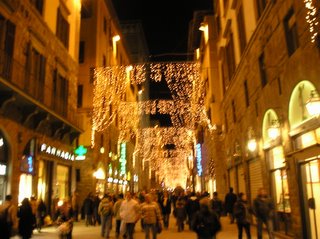
_______________________________________________________________
An oversight on my part during trip-planning, meant that our only full day in Florence was a Monday, when most of the museums are closed, hence yesterday's rush to the Uffizi. This afforded us, however, a day to stroll about, free of my obsessive art-fervour. We had a look-ee at the Duomo, Santa Maria del Fiore,

and adjacent Campanile Giotto,

strolled east through various neighbourhoods


and collated some lunch from the markets,

which we ate on the banks of the Arno.


South of the river, we hiked up the hill to the Fortress Belvedere and had a look at Palazzo Pitti

and several churches: Santa Spirito & Santa Maria del Carmine.


Crossed the Ponte Vecchio


and moseyed through the centre of town, enjoying the afternoon light on the beautiful buildings there.





Ate the remains from our lunch for dinner and drank two bottles of chianti, after which conversation with fellow hostel guests became tolerable.
__________________________________________________________________
Our final morning in Florence and the last chance to see the Academia, which we did. It was good, though reaching threshold for consumption of art from 1300 to 1700. In Maarinke's words: if i see one more Virgin and Child or Annunciation or Pieta, I'm going to scream.
In my words: Do you think David killed Goliath to make up for not being quite "correctly proportioned" - you couldn't just go out and buy a big car in those days, you know.
In Maarinke's words (in front of the David): Matt, stop gesturing like that with your hands; everyone knows what you're talking about.
It's great being arty and cultured and stuff.
Haste at Academia gave us time for a final walk round before returning to Rome. The walk went a little something like this:

We walked to Piazza Santa Croce,

paid tribute to a famous Florentine,

bought some more spinach balls for the hungry vegetarian, and checked out the markets before bidding Florence farewell.
 Back in Rome (managed to not miss train this time), we dumped stuff @ hostel, trying to suppress Australian accents to avoid bearing any resemblance to fellow countrymen staying there (the great irony of hostelling being that you travel half way round the world to expand your mind and/or horizons and end up sharing a room with someone who used to work with the father of someone you once tutored or, in the case of Rome, are checked in by someone who went to your high school and share a room with someone who is about to start work at the same place one of your mates does (RBA, in case you're reading Grant)).
Back in Rome (managed to not miss train this time), we dumped stuff @ hostel, trying to suppress Australian accents to avoid bearing any resemblance to fellow countrymen staying there (the great irony of hostelling being that you travel half way round the world to expand your mind and/or horizons and end up sharing a room with someone who used to work with the father of someone you once tutored or, in the case of Rome, are checked in by someone who went to your high school and share a room with someone who is about to start work at the same place one of your mates does (RBA, in case you're reading Grant)).
As antidote to overdose of chiarascuros, pietas, altarpieces etc, we went to the Galleria Nazionale d'Arte Moderna, stopping off to be stereotypically (and, given above rant, hypocritically) Australian by drinking a couple of longnecks in the park (the Giardin del Lago mind you, right near the Piazza di Siena, and it was Morretti we were drinking, so it was all pretty authentico derelicto behaviour).

It was more like the Art Gallery of NSW than the Uffizi or the Musei Vaticani (and if you could imagine how many people would go to the AGNSW, no disrespect intended, if it were transplanted to Rome, you would overestimate the attendance at the GNAM by a factor of 2). The collection there is big, spanning the 19th to 21st centuries, and there is a lot of good stuff, both Italian and international. The problem is, i suppose, that whilst Italy is famous for (1) Roman antiquity and (2) most famous art from 1300 to 1700, from Giotto and Cimabue through Da Vinci, Santi, Buonarotti, Tiziano, Corregio, Veronese etc. to Caravaggio, Tiepolo, Tintoretto and Canaletto etc, (blahblahblah, look at me, i'm a dancing monkey who can recite lots of artists names, give me a banana), things had gone pretty quiet from 1750 when the baton had definitely been passed to France (having been shared with Flanders & Holland admittedly from 1600 on) and then also to England, Germany, etc. That's not to say that painters weren't painting in Italy, and that Italy wasn't important in terms of art: the Prix de Rome remained a most prestigious award at the Academy in Paris throughout the 1800s and artists have continually travelled there to seek inspiration and learn technique. For various reasons, political, social, religious and artistic (and combinations thereof), the most progressive, exciting, novel art, the stuff that gets written about in art books, and initiates movements that we can label and praise, particularly in this modern age that prizes conceptual novelty over perfection of craft (Hirst shark, take a bow), was done elsewhere.
The collection at the Galleria Nazionale d'Arte Moderna clearly demonstrated that there were lots of artists doing lots of good work, following roughly the progression of "The Canon": neoclassicism, romanticism, painting en plein air, realism, impressionism, post-impressionism, expressionism, cubism, abstraction (blahblahblah, this time i'm reciting movements, another banana please), then the multiplicity of forms, styles, media that characterise the modern and postmodern ages, but generally a few years behind the cutting edge. Coming from Australia, which wouldn't be claimed as a centre of any international art movements, but which has it's own "story of art" that is understood in the context of, but is not dictated by, the international story, i could appreciate the Italian art we saw there. It wasn't Ingres, Delacroix, Turner, Manet, Monet, Renoir, Van Gogh, Cezanne, Picasso (here I go again...; though there were a couple of them represented there), but it was good interesting stuff that reflected developments in art and society at the time. And no altarpieces.
Probably for me the most exciting pieces at the Galleria Nazionale d'Arte Moderna were the works of the Futurists (Boccioni, Carra, Severini), who lamented some of these things about which I have rambled above, Italy's departure from the centre of art etc, and who captured some of the dynamism of the modern technological world in their fractured, abstractified images.
Maarinke dug the 20c abstracts too:

After all that waffling, the general moral of the story was that good art doesn't have to be famous art, and being two of the eight people in the entire museum, including staff, beats pushing through crowds at the Vatican hands down. And it was time for a couple of quiet ones.
Big dinner to farewell Italy: bruschetta & breadsticks to start, fettucini vongole & spaghetti napoletana respectively for entree, sangiovese to drink, osso bucco & zuppa di pesce resp. for mains, panetone and grappa (doubles x 2) to finish.
____________________________________________________________
Final morning in Italy: enough time for one more authentico experience, a stroll to the Campo di Fiore. Rome was bustling by the time we dragged ourselves out of bed (a special thanks to the (you guessed it) Australians sharing our hostel room for returning drunk at 4am from their swim in the Fontana di Trevi - yet another moment to make me so proud of my country) but it was cool to see the city in a different light (though in mid-winter the direction of the sun doesn't change a whole lot between 8am and 4pm).



Bought some dates at the Campo di Fiori markets (at €20/kg, we were paying for the experience as well as the dates), then returned to the hostel for breakfast and timely check-out.

Then it was off to Fiumicino for us and, after some complications involving my flight on El Cheapo (or more linguistically appropriately, Das Cheapen) Air being cancelled and me only finding out about it after I'd asked four different officials, we boarded a Lufthansa (woohoo, an upgrade for me - definitely landing on my feet with regards to transport, Birmingham train fiasco notwithstanding) flight to Munich.
It was a pretty clear day so we could see Venice (only just!)

and the alps, which were spectacular.

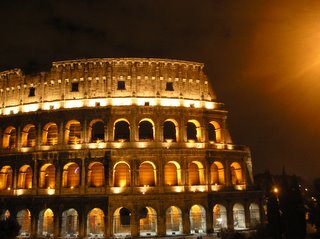


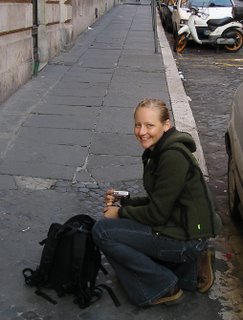










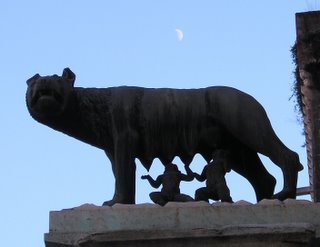


 It appears to be a great cliche to criticise this monument in comparison with the graceful ruins of antiquity that surround it, or with the renaissance and baroque palazzos and chiesas that constitute much of the city. It is representative of Italy's move into nationhood after more than 1200 years: in this day of pan-Europeanism, as distinctions between states become more blurred, such commemorative pieces give reminders of the relative modernity of the concept of nationhood. It was good to enjoy this perspective over history, whilst also appreciating the view over the city.
It appears to be a great cliche to criticise this monument in comparison with the graceful ruins of antiquity that surround it, or with the renaissance and baroque palazzos and chiesas that constitute much of the city. It is representative of Italy's move into nationhood after more than 1200 years: in this day of pan-Europeanism, as distinctions between states become more blurred, such commemorative pieces give reminders of the relative modernity of the concept of nationhood. It was good to enjoy this perspective over history, whilst also appreciating the view over the city. 










 The Pinacoteca was also cool (though we were to later discover that the bulk of the Baroque pieces were being exhibited in Bonn at the time). Lunch and a bottle of paint stripper was followed by a quick visit to St Peters piazza,
The Pinacoteca was also cool (though we were to later discover that the bulk of the Baroque pieces were being exhibited in Bonn at the time). Lunch and a bottle of paint stripper was followed by a quick visit to St Peters piazza,

